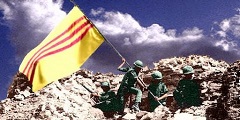JANUARY 23, 2014 | 11:17PM PT Rory Kennedy's documentary combines astonishing footage from Saigon in April 1975 with contemporary recollections from some who were there.
Vividly annotating one of the most haunting images of the Vietnam War, that of dozens of South Vietnamese struggling to climb the steps to a rooftop helicopter as Saigon fell, Rory Kennedy’s “Last Days in Vietnam” combines astonishing footage from April 1975 with the contemporary recollections of some who were there. That the pool of interviewees consists largely of guilt-ridden former U.S. military officials makes sense given the documentary’s commission by American Experience Films; the Vietnamese experience isn’t much reflected here. To the extent that one can accept such limitations, “Last Days” makes a worthy addition to the historical record.
Kennedy’s film focuses the bulk of its attention on the taut 24-hour period that saw the evacuation from Saigon of thousands of U.S. and South Vietnamese military personnel, along with a small number of civilians. Alas, the docu’s accomplished summary of tension-filled events as they transpired from minute to minute comes at the expense of wide-angle historical context, the sort that could help explain the tragic delay of evacuation efforts in terms of Americans’ collective unwillingness to accept defeat for nearly the first time.
As it stands, “Last Days” locates the core of stubborn American pride in the figure of the late Graham Martin, who served as U.S. ambassador to South Vietnam from 1973, the year of the Paris Peace Accords. Martin, whose complex character could easily occupy a documentary by itself, refused for months to admit that Saigon would likely fall to the fast-encroaching North Vietnamese Army, declining until the 11th hour to prepare for the safe transport of those who remained in the city.
Thus it was left to U.S. Army Capt. Stuart Herrington, the film’s principal talking head, to organize the clandestine evacuation of as many South Vietnamese Army members as possible under the circumstances. Another evidently courageous figure interviewed in the documentary is former Dept. of Defense official Richard Armitage, who conspired with South Vietnamese Navy Capt. Kiem Do to ship some 30,000 refugees out of the country. (The total number of refugees in South Vietnam was close to a million, many of whom, as an end title card explains, were detained or executed.)
South Vietnamese interviewees are limited to four, including one refugee, while no one oncamera describes the impact of U.S. anti-war protests upon events, including the congressional decision to cut off aid to the South Vietnamese army. Former secretary of state Henry Kissinger dances around the relevant issues in an apparently prepared statement; Herrington, despite the difficult position he was in, admits his “betrayal” of the South Vietnamese who remained in Vietnam after the final helicopters took flight.
Editor Don Kleszy expertly weaves interview material together with harrowing archival footage, much of it showing the desperation of Saigon citizens. Doug Whitney’s digital animation of maps indelibly illustrates the surge of the North Vietnamese to the south; music by Gary Lionelli enhances the film’s emotional quality. All other tech credits are superb.




 Reply With Quote
Reply With Quote
Bookmarks